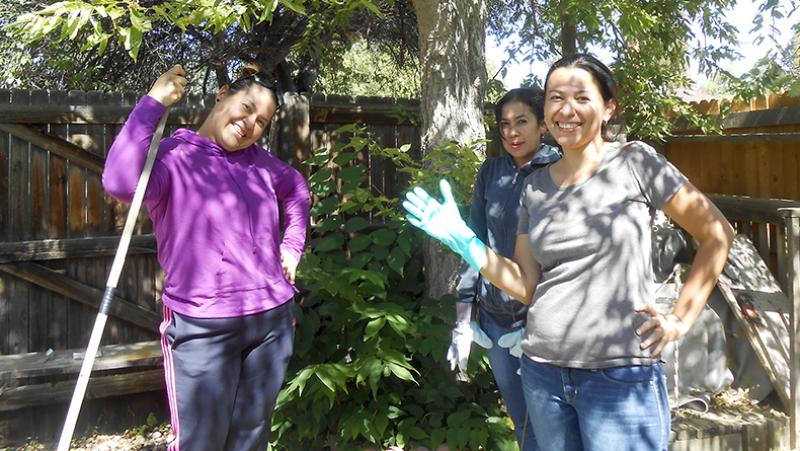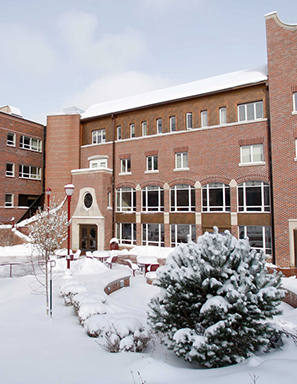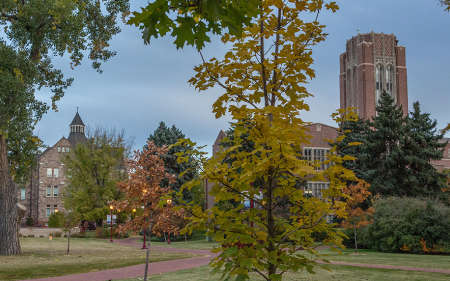Community-Engaged Education
As part of a new initiative, MSW students helped a community health partner to understand the complex concept of timebanks

All people are of equal value, and so is their time. That’s one of the core tenets of timebanking — a time-based currency that exchanges one “credit” for one hour of service to another person; credits can be used to pay for other services offered through the timebank.
Timebanks are a complex, equity-focused concept that MSW students explored recently in the University of Denver Graduate School of Social Work (GSSW) course Wellness Promotion Across the Lifespan. As part of a new community-engaged learning initiative, the course was offered in collaboration with 2040 Partners for Health, which works to end health disparities and improve the health in the Denver-area communities they serve.
The course has always been oriented to service learning and community engagement, notes instructor Kate Ross, associate professor of the practice. What’s new this year is that Director of Community Engagement Trish Becker-Hafnor staffed the partnership, from conceptualization of the partnership to collaborating in course planning to drafting the project agreement. The course is one of three courses piloting this more intensive — and intentional — community-engagement approach, which emerged from GSSW’s strategic plan.
Importantly, Ross and Becker-Hafnor note, the initiative’s goal is to create mutually beneficial partnerships and leverage the assets of the school to benefit the community — not just use the community as a learning lab.
In the case of 2040 Partners for Health, the course collaboration called on students to explore the concept and structure of timebanks, identify community assets and propose an approach for culturally responsive implementation. The organization had hosted the Aurora Timebank, but it was languishing, and the organization lacked the capacity to investigate how to revive the timebank, or even whether it should. Students explored everything from technology to safety to varied cultural understandings of reciprocity.
Students researched what has worked, and what hasn’t, in timebanks in the U.S. and around the world. “An interesting piece of what hasn’t worked in the past is that health providers have used timebanks as a way to incentivize participation in wellness programs,” Ross notes. “But it was coercive and didn’t meet individual needs. The timebank loses currency unless people are getting what they really need.” Those needs cannot be prescribed by others; communities themselves must take ownership.
Health & Wellness MSW student Jaci Gandenberger was part of a student group that explored the role of cultural awareness and cultural competency in timebank implementation. For example, she explains, communities of color are disproportionally impacted by the criminal justice system, so you may not want to exclude all individuals with a criminal background from the timebank. At the same time, people who have been victims may feel uncomfortable around those with a criminal record. One potential solution is for people with a criminal record to provide services in a public place rather than in a participant’s home.
Students presented their findings to the 2040 Partners board, executive director, and community members — Gandenberger’s first graduate school experience with accountability to a community partner.
“I don’t know if we’ve solved timebanking, but our students’ role was to help our community partner think about and understand the issue in more depth,” Ross says.
“I am so grateful for the opportunity, the wonderful experience and the attention to detail,” says 2040 Partners Executive Director Griselda Peña-Jackson, noting that Ross and Becker-Hafnor guided her through the process, making the experience of working with the school and with students easy. “Our board and community members who attended were so impressed, and we were all buzzing with ideas when we left. Thank you for truly keeping community at the center of your work!”
“This timebanking project is pretty radical,” says Gandenberger, who plans to continue health- and wellness-related research and policy work after she graduates in June. “It’s a paradigm shift about how most of us think about people’s work and economic value. Getting my mind around this new way of looking at it and thinking about how to create something sustainable and feasible when you’re asking everyone involved to make this paradigm shift, too — it’s a massive undertaking.”
But, she adds, “I learned a lot of skills and processes around how you take an idea and break it down to its component parts and think about how you could actually implement this in the real world.”
That type of learning is the outcome Ross and Becker-Hafnor were hoping for. “The questions we asked were huge, and the timebank concept itself is challenging to grasp. It’s complicated, but work in community is complicated,” Becker-Hafnor says. “As a social worker, you’ll be working with ambiguity.”
Community-engaged learning “is a deeper kind of learning that integrates concepts and creates the opportunity to forge skills that students will need in the future,” Ross adds.
Gandenberger agrees. “Having this real-world component made it feel different from my other classes,” she says. “This was such a valuable experience.”





